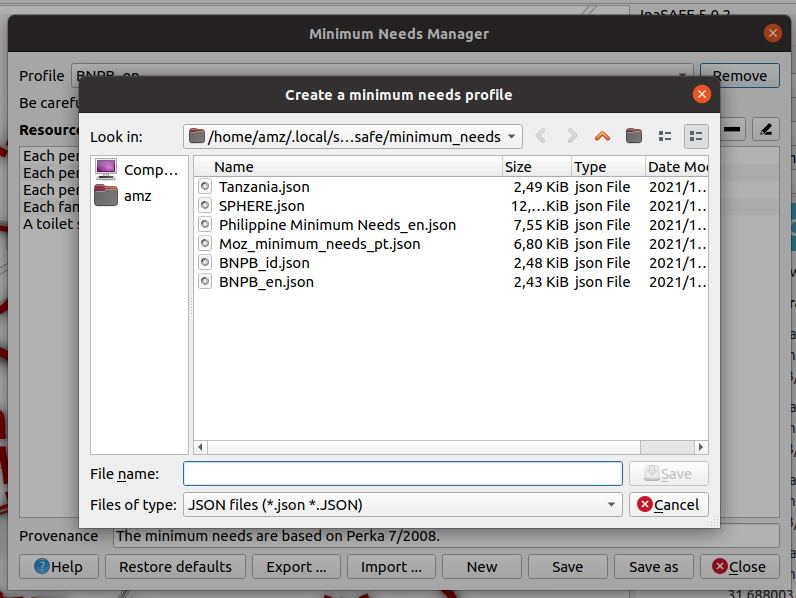
Understanding InaSAFE Minimum needs
“InaSAFE includes logic to compute the humanitarian relief requirements (minimum needs) for displaced persons. This module explains minimum needs.”
During and after a disaster, providing for the basic human minimum needs of food, water, hygiene and shelter is an important element of your contingency plan. InaSAFE has a customisable minimum needs system that allows you to define country or region specific requirements when compiling a needs report where the exposure layer represents population. By default InaSAFE uses minimum needs defined for Indonesia – in the exercise below we create our own minimum needs profile.
You try:
Goal: Understand the concept of minimum needs.
-
Open the Global Minimum Needs Configuration (Plugins -> InaSAFE -> InaSAFE Minimum Needs Configuration).
-
Create a new profile using the ‘new’ button at the bottom of the dialog (see image below).
-
Call your profile ‘Training’ and save it as the default location.
-
Add a new resource (hint use the tooltips to find the correct button for that). Use the requirements table below to set the resource properties.
Minimum needs breakdown
| Aggregation Area | Total displaced population | Rice [KG] | Drinking water [l] | Clean water[l] | Family kits | Toilets |
|---|---|---|---|---|---|---|
| Ndugumbi | 40 | 100 | 630 | 2400 | 10 | 10 |
| Kawe | 30 | 90 | 540 | 2100 | 10 | 10 |
| Total | 70 | 190 | 1200 | 4500 | 20 | 10 |
- Save your profile (image below). Now restart QGIS and run the flood on population analysis again.
Check your results:
What were the minimum needs requirements listed in your repo


More about
Minimum needs are grouped into regional or linguistic ‘profiles’. The default profile is ‘BNPB_en’ - the English profile for the national disaster agency in Indonesia. You will see that their profile defines requirements for displaced persons in terms of Rice, Drinking Water, Clean Water (for bathing etc.), Family Kits (with personal hygiene items) and provision of toilets.
Each item in the profile can be customised or removed. For example selecting the first item in the list and then clicking on the ‘pencil’ icon will show the details of how it was defined.
If you scroll up and down in the panel you will see that for each item, you can set a name, description, units (in singular, plural and abbreviated forms), specify maxima and minima for the quantity of item allowed, a default and a frequency. You would use the maxima and minima to ensure that disaster managers never allocate amounts that will not be sufficient for human livelihood and also that will not overtax the logistics operation for those providing humanitarian relief.
The final item in the item configuration is the ‘readable sentence’. Using a simple system of tokens you can construct a sentence that will be used in the generated needs report.
Once your needs profile is saved, you can share it with other users or submit it to the InaSAFE project for general sharing to all InaSAFE users.
NOTE: Minimum needs will be calculated according to whichever needs profile is selected in the minimum needs manager.

Check your knowledge:
-
Minimum needs help to calculate humanitarian aid requirements for everyone in the affected area:❗
- True
- False
-
Mark all the correct statements:❗
- If you want to share your minimum needs profile you can submit it to the InaSAFE developers and we will ship it with InaSAFE.
- Minimum needs works with the following population, roads, buildings.
- You need to enable an option in a hazard layer keywords in order for minimum needs to be calculated.

Further reading:
-
See the minimum needs tool section in the InaSAFE user manual at: http://manual.inasafe.org/en/index.html#Minimum-needs
❗ -
Read about the international needs profile defined by SPHERE: http://www.sphereproject.org/handbook/
❗
Download the sample data for the lesson.
